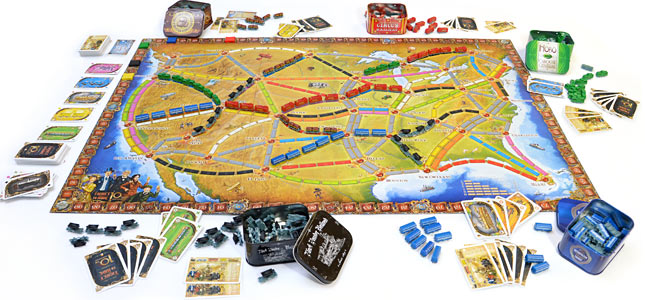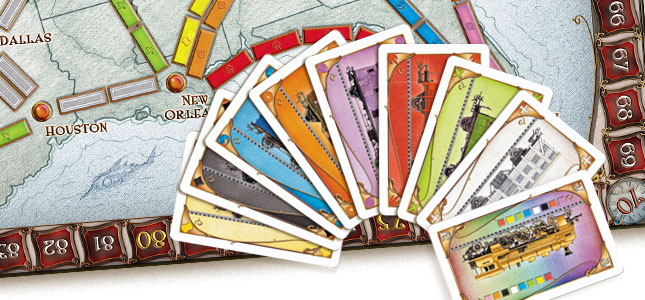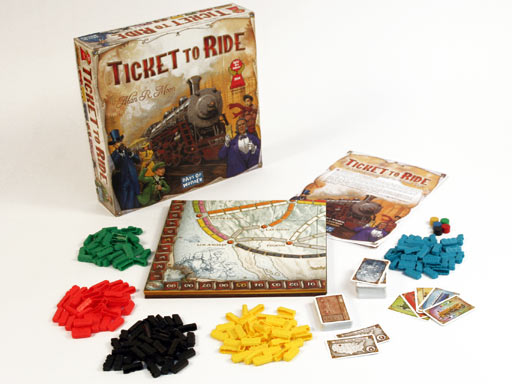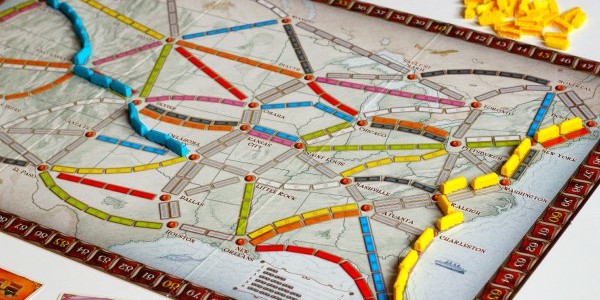 Ticket to Ride is the game that changed the face of GamerNode, expanding our horizons to encompass not only the digital video games that I’ve enjoyed since my childhood in the 1980s, but their analog ancestors as well. Without Ticket to Ride, my board game experience would perhaps remain in the realm of Monopoly, Clue, Life, and Scrabble. These were of course great games in their time, but they’ve arguably been replaced by a whole new world of “designer” board games, from deep, German-inspired Eurogames to the thematic, cinematic, luck- and conflict-driven Ameritrash games of today. Aaaaaaaaaaaaalllllllll aboooooaaarrrrd!
Ticket to Ride is the game that changed the face of GamerNode, expanding our horizons to encompass not only the digital video games that I’ve enjoyed since my childhood in the 1980s, but their analog ancestors as well. Without Ticket to Ride, my board game experience would perhaps remain in the realm of Monopoly, Clue, Life, and Scrabble. These were of course great games in their time, but they’ve arguably been replaced by a whole new world of “designer” board games, from deep, German-inspired Eurogames to the thematic, cinematic, luck- and conflict-driven Ameritrash games of today. Aaaaaaaaaaaaalllllllll aboooooaaarrrrd!

Ticket to Ride is perhaps the quintessential modern gateway board game. With simple rules that borrow heavily from the classic card game, Rummy, a reasonably short play time of 30-60 minutes, the ability to accommodate 2-5 players, a very inviting graphical presentation, and the naturally intuitive spatial mechanics of route and network building, this modern classic is perfect for introducing players to the board gaming hobby, and deserves a space on any tabletop enthusiast’s shelf.
The game plays out on a map of the United States (or Europe, or Asia, or India, or the U.K., or Pennsylvania, or Africa, etc., depending on the expansions to which your addiction has led you), with a number of cities connected by colored train routes measuring one to six spaces long. Players manage hands of various train cards in the same colors as the routes, and strive to collect sets of matching cards to discard in exchange for laying claim to routes on the board. For example, playing three red train cards on your turn allows you to mark a three-space route on the board as your own, using three of the tiny plastic train markers from your personal supply.

There are three separate options on a given turn. A player may draw two cards either from the face-down deck placed near the main board, or from the tableau of five face-up cards placed next to the deck. Rainbow-colored locomotive cards act as wild cards, and can serve as any color, but also restrict players from drawing a second card if taken from the face-up spread. If enough cards to claim a route are already in hand, the player may claim a route as mentioned above, earning points based on the length of the route. Finally, one may draw new Destination Tickets to increase his or her ultimate point-earning potential.
A huge part of the competitive spirit of Ticket to Ride revolves around completing multi-city routes across sections of the country, as prescribed by Destination Tickets, which remain secret from opposing players until the end of the game. Because each path between cities can only be claimed once (a select few can be claimed twice in four- or five-player games), the first player to do so essentially locks all other players out, causing them to take contingency actions to complete their valuable Destination Ticket routes. Doing so is important because while they can net a player lots of points, failing to complete a ticket results in the loss of the point value listed on the card. As such, it’s not uncommon to watch players earn end-game bonuses of 50 points thanks to their careful maneuvering during the game. Or alternatively, lose dozens of points because they ignored their cards.

There is a perfect level of player interaction in Ticket to Ride, lots of laughing and grumbling at one another for claiming a particular route, and decent degrees of strategy, tactics, and bluffing. The game scales beautifully, meaning it plays just as well with two, five, or any number of players in between, and it’s accessible by beginners and veterans alike. It’s also wonderfully paced, with very few of the long pauses between player turns that can grind the fun out of a game.
What’s better is that it opens up a world of new board gaming opportunities, and gets players wondering what exactly they might be missing on the tabletop. Ticket to Ride is definitely a must-play, and I believe a must have to fill that lightweight gateway or family niche in a board gamer’s collection. Don’t miss the train; go grab a copy now!


















